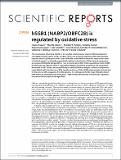Files in this item
hSSB1 (NABP2/OBFC2B) is regulated by oxidative stress
Item metadata
| dc.contributor.author | Paquet, Nicolas | |
| dc.contributor.author | Adams, Mark N | |
| dc.contributor.author | Ashton, Nicholas W | |
| dc.contributor.author | Touma, Christine | |
| dc.contributor.author | Gamsjaeger, Roland | |
| dc.contributor.author | Cubeddu, Liza | |
| dc.contributor.author | Leong, Vincent | |
| dc.contributor.author | Beard, Sam | |
| dc.contributor.author | Bolderson, Emma | |
| dc.contributor.author | Botting, Catherine H | |
| dc.contributor.author | O'Byrne, Kenneth J | |
| dc.contributor.author | Richard, Derek J | |
| dc.date.accessioned | 2016-06-15T11:30:04Z | |
| dc.date.available | 2016-06-15T11:30:04Z | |
| dc.date.issued | 2016-06-08 | |
| dc.identifier | 243430143 | |
| dc.identifier | f4a0c935-021c-46b8-84b4-a747e533f6d8 | |
| dc.identifier | 27273218 | |
| dc.identifier | 84976383986 | |
| dc.identifier | 000377461900001 | |
| dc.identifier.citation | Paquet , N , Adams , M N , Ashton , N W , Touma , C , Gamsjaeger , R , Cubeddu , L , Leong , V , Beard , S , Bolderson , E , Botting , C H , O'Byrne , K J & Richard , D J 2016 , ' hSSB1 (NABP2/OBFC2B) is regulated by oxidative stress ' , Scientific Reports , vol. 6 , 27466 . https://doi.org/10.1038/srep27446 | en |
| dc.identifier.issn | 2045-2322 | |
| dc.identifier.uri | https://hdl.handle.net/10023/8987 | |
| dc.description.abstract | The maintenance of genome stability is an essential cellular process to prevent the development of diseases including cancer. hSSB1 (NABP2/ OBFC2A) is a critical component of the DNA damage response where it participates in the repair of double-strand DNA breaks and in base excision repair of oxidized guanine residues (8-oxoguanine) by aiding the localization of the human 8-oxoguanine glycosylase (hOGG1) to damaged DNA. Here we demonstrate that following oxidative stress, hSSB1 is stabilized as an oligomer which is required for hSSB1 to function in the removal of 8-oxoguanine. Monomeric hSSB1 shows a decreased affinity for oxidized DNA resulting in a cellular 8-oxoguanine-repair defect and in the absence of ATM signaling initiation. While hSSB1 oligomerization is important for the removal of 8-oxoguanine from the genome, it is not required for the repair of double-strand DNA-breaks by homologous recombination. These findings demonstrate a novel hSSB1 regulatory mechanism for the repair of damaged DNA. | |
| dc.format.extent | 1644604 | |
| dc.language.iso | eng | |
| dc.relation.ispartof | Scientific Reports | en |
| dc.subject | QD Chemistry | en |
| dc.subject | QH301 Biology | en |
| dc.subject | NDAS | en |
| dc.subject | SDG 3 - Good Health and Well-being | en |
| dc.subject.lcc | QD | en |
| dc.subject.lcc | QH301 | en |
| dc.title | hSSB1 (NABP2/OBFC2B) is regulated by oxidative stress | en |
| dc.type | Journal article | en |
| dc.contributor.institution | University of St Andrews. School of Biology | en |
| dc.contributor.institution | University of St Andrews. School of Chemistry | en |
| dc.contributor.institution | University of St Andrews. EaSTCHEM | en |
| dc.contributor.institution | University of St Andrews. Biomedical Sciences Research Complex | en |
| dc.identifier.doi | https://doi.org/10.1038/srep27446 | |
| dc.description.status | Peer reviewed | en |
| dc.identifier.url | http://www.nature.com/articles/srep27446?WT.feed_name=subjects_biological-sciences#supplementary-information | en |
This item appears in the following Collection(s)
Items in the St Andrews Research Repository are protected by copyright, with all rights reserved, unless otherwise indicated.

